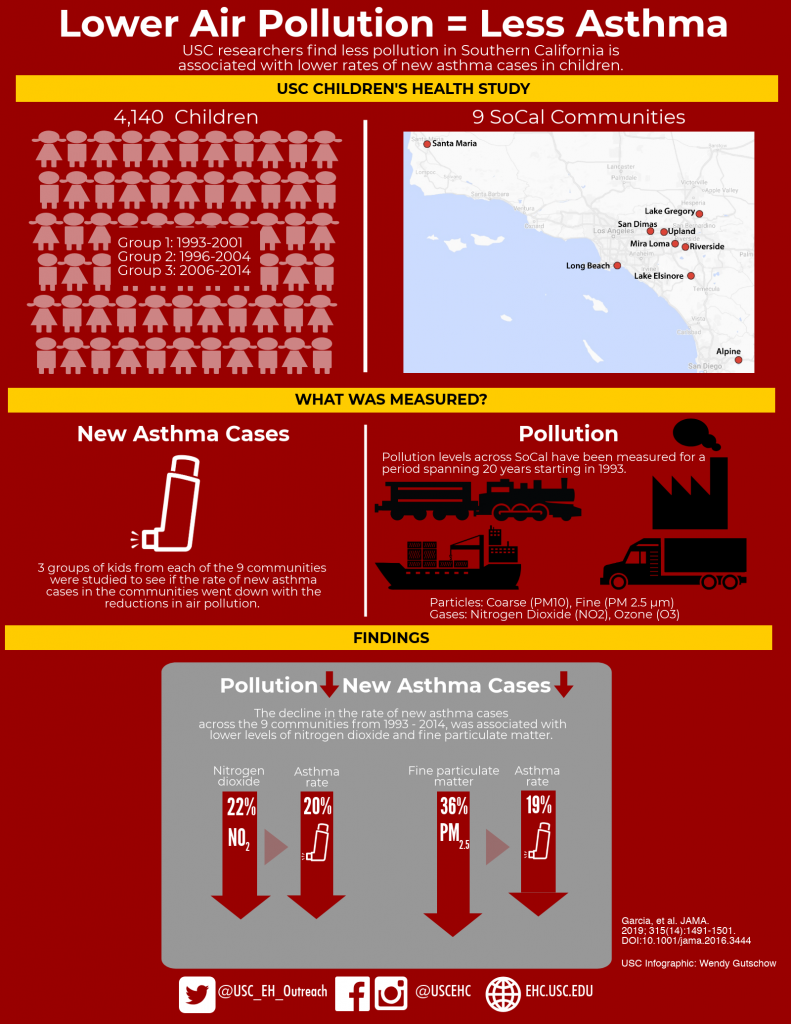
PRESS COVERAGE: National Public Radio, Reuters,
Improved air quality in the Los Angeles region is linked to roughly 20 percent fewer new asthma cases in children, according to a USC study that tracked Southern California children over a 20-year period.
The findings appear in the May 21 issue of the Journal of the American Medical Association.
The research expands on the landmark USC Children’s Health Study, which found that children’s lungs had grown stronger in the previous two decades and rates of bronchitic symptoms decreased as pollution declined throughout the region.
“While the findings show a clear benefit of lower air pollution levels, there must be continued efforts to reduce pollution in our region,” said first author Erika Garcia, a postdoctoral scholar in the Department of Preventive Medicine at the Keck School of Medicine of USC. “We’re not in a place where we can stop and say, ‘Hey, we’ve arrived’.”

Los Angeles remains the nation’s most-polluted region, but air quality improvements between 1993 and 2006 cut nitrogen dioxide pollution by 22 percent and fine particulate matter by 36 percent.
Nitrogen dioxide can cause airway inflammation and airway hyper-responsiveness. Particulate matter — tiny particles of soot, smoke dust, etc. — can penetrate deep into the lungs and cause serious health problems.
To assess new-onset cases of asthma, USC scientists used data from 4,140 children in nine California communities: Alpine, Lake Elsinore, Lake Gregory, Long Beach, Mira Loma, Riverside, San Dimas, Santa Maria and Upland. Parents or guardians completed questionnaires regarding their children’s health. New-onset asthma was defined as a newly reported, physician-diagnosed case of asthma on an annual questionnaire during follow-up.
Researchers looked at rates of new-onset asthma alongside air pollution data collected from monitoring stations in each of those communities during three different periods: 1993-2001, 1996-2004 and 2006-2014. Using statistical methods, they separately examined four air pollutants and found that two were associated with reductions in new-onset asthma. They estimated that the nitrogen dioxide reductions achieved between 1993 and 2006 led to a 20 percent lower rate of asthma, while fine particulate matter reductions led to a 19 percent lower rate.
The findings add to the increasing scientific evidence supporting the role of air pollution in the development of new cases of asthma. Asthma is the most common chronic disease in children, affecting about 14 percent of children around the world, and a major contributing factor to missed time from school and work.
“This is encouraging news as it shows the number of new cases of asthma in children can be reduced through improvements in air quality,” said Kiros Berhane, a professor of preventive medicine at the Keck School of Medicine of USC and one of the study’s authors. “This is very likely a direct result of the science-based environmental policies that have been put in place.”
In addition to Garcia and Berhane, the study’s other authors are Talat Islam, Rob McConnell, Robert Urman, Zhanghua Chen and Frank Gilliland, all of the Department of Preventive Medicine at the Keck School of Medicine.
The research was supported by the National Institute of Environmental Health Sciences (grants P30ES007048, P01ES009581, R01ES021801, and R01ES025786), the National Heart, Lung and Blood Institute (grant R01HL118455), the United States Environmental Protection Agency (grants R826708 and RD831861), and the Hastings Foundation.